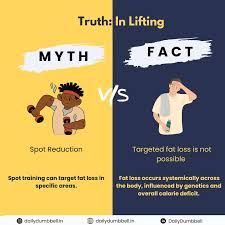When it comes to fitness and weight loss, one of the most persistent claims is the idea of “targeted fat loss,” or the ability to shed fat from specific areas of the body through targeted exercises. But how much truth is there to this concept? Is it scientifically supported, or is it just another fitness myth? In this article, we’ll explore the science behind targeted fat loss, debunk common misconceptions, and provide actionable tips for effective fat loss strategies.
What Is Targeted Fat Loss?
Targeted fat loss, also known as “spot reduction,” is the belief that performing exercises that focus on a specific body part—such as crunches for the stomach or leg lifts for thighs—can help reduce fat in that area. For decades, fitness enthusiasts and marketers have promoted this idea, fueling a multimillion-dollar industry of specialized workouts and gadgets.
However, the science behind targeted fat loss paints a different picture.
The Science of Fat Loss
To understand why targeted fat loss is largely considered a myth, it’s essential to know how the body burns fat.
How Fat Loss Works
- Caloric Deficit: Fat loss occurs when you burn more calories than you consume, creating a caloric deficit. This prompts your body to use stored fat as an energy source.
- Hormonal Regulation: Hormones like insulin, cortisol, and catecholamines play a significant role in fat metabolism, determining where and how quickly fat is burned.
- Body-Wide Process: Fat is released from fat cells (adipocytes) throughout the body, not just from the area being exercised. This means that even if you’re doing countless sit-ups, your body doesn’t exclusively burn belly fat—it burns fat from wherever it’s genetically predisposed to lose it first.

Research on Targeted Fat Loss
Multiple studies have debunked the myth of spot reduction. For instance:
- A 2011 study published in the Journal of Strength and Conditioning Research found that performing six weeks of abdominal exercises did not significantly reduce abdominal fat.
- Another study in 2013 examined participants who performed high-repetition leg exercises. While they improved muscle endurance, there was no significant fat loss specifically in their legs.
These findings reinforce the idea that while targeted exercises can build strength and muscle in specific areas, they don’t directly impact fat loss in those regions.
Common Myths About Targeted Fat Loss
Let’s address some common misconceptions:
Myth 1: Crunches Burn Belly Fat
Performing endless crunches may strengthen your core, but it won’t specifically reduce belly fat. Instead, overall fat loss through a combination of diet and exercise is necessary to see a toned midsection.
Myth 2: Spot-Toning Devices Work
Many gadgets claim to target specific areas for fat loss, such as waist trimmers or vibrating belts. While these may increase sweat production, they don’t burn fat.
Myth 3: High-Rep, Low-Weight Exercises Reduce Fat Locally
While high-rep, low-weight exercises can improve muscle endurance, they don’t target fat in a specific area. Fat loss still depends on overall caloric expenditure.
What Actually Works for Fat Loss?
If spot reduction doesn’t work, what does? Here are evidence-based strategies to achieve effective fat loss:
1. Combine Strength Training with Cardio
- Strength Training: Builds lean muscle, which increases your resting metabolic rate (RMR) and helps burn calories more efficiently.
- Cardio: Activities like running, cycling, and swimming are excellent for burning calories and creating a caloric deficit.
2. Focus on a Balanced Diet
- Prioritize whole, nutrient-dense foods like lean proteins, vegetables, whole grains, and healthy fats.
- Monitor portion sizes and avoid excess sugar and processed foods.
- Stay hydrated to support metabolism and overall health.
3. Incorporate High-Intensity Interval Training (HIIT)
HIIT workouts involve short bursts of intense activity followed by brief rest periods. Research shows that HIIT can be highly effective for fat loss while preserving muscle mass.
4. Manage Stress and Sleep
Chronic stress and poor sleep can disrupt hormonal balance, leading to fat storage, particularly around the midsection. Prioritize 7-9 hours of quality sleep and stress-reduction techniques like mindfulness or yoga.
5. Be Patient and Consistent
Fat loss takes time, and progress can vary from person to person due to genetics, age, and other factors. Stay consistent with your efforts and celebrate non-scale victories, such as improved energy or strength.
Conclusion: The Reality of Targeted Fat Loss
The idea of targeted fat loss is an appealing concept but is not supported by scientific evidence. While you can’t control where your body loses fat, a holistic approach that combines strength training, cardio, a healthy diet, and lifestyle changes can help you achieve your fat loss goals. Focus on overall fitness and health rather than chasing quick fixes or gimmicks.
Remember, every body is unique. Embrace the process and aim for sustainable habits that support your long-term well-being.
FAQ: Targeted Fat Loss
1. Can I lose belly fat by doing sit-ups?
No, sit-ups strengthen your abdominal muscles but don’t specifically burn belly fat. Overall fat loss through a caloric deficit is necessary.
2. What is the best exercise for fat loss?
A combination of strength training and cardio is most effective. High-Intensity Interval Training (HIIT) is particularly efficient for burning calories.
3. How long does it take to see fat loss results?
Results vary depending on factors like diet, exercise consistency, and genetics. Typically, noticeable changes occur after 4-8 weeks of consistent effort.
4. Are there any supplements for targeted fat loss?
No supplement can target fat loss in specific areas. Focus on a balanced diet and consult a healthcare professional before taking any supplements.
5. Why do I lose fat from some areas faster than others?
Fat distribution is largely determined by genetics and hormones. Some areas may take longer to show fat loss.
Meta Description Discover the truth about targeted fat loss. Learn the science, debunk myths, and find effective strategies for overall fat loss and sustainable fitness.